Figure 9.

Chemical inhibition or genetic ablation of caspase-2 delays apoptosis induced by invasive Salmonella. Primary bone marrow–derived macrophages isolated from wt, caspase-2–deficient (casp-2−/−), or caspase-1–deficient (casp-1−/−) mice were stained with DAPI and infected with wt Salmonella as described in the legend to Fig. 1. (A) wt (closed bars) and caspase-2–deficient (open bars) macrophages were infected with wt Salmonella. (B) wt macrophages were either left untreated (closed bars) or were treated with a caspase-2 inhibitor (Z-VDVAD-fmk, 100 μM; open bars) for 90 min before infection. (C) Caspase-1–deficient macrophages were either left untreated (open bars) or were treated with a caspase-2 inhibitor as described above. The percentage of cells containing condensed chromatin was determined as described in the legend to Fig. 1, at different points after infection. The SD was <5% in all cases, and it has been omitted.
